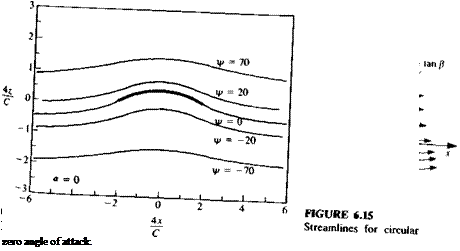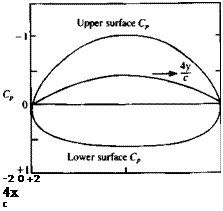Circular Arc Airfoil
The center of the circle is chosen on the imaginary axis in the f plane fi = im and from Eq. (6.27) a = Cl4 sec /3 and m = a sin /3. This results in the circulai arc airfoil shown in Fig. 6.14a with chord с = C. Note that since the circlf passes through both critical points A and D, the corresponding points on thjf airfoil are sharp. Also, points B[f = i(a + m)] and E[f = — i(a – m)] on th{! circle, at the top and bottom, both transform to the same point on the аігіоЦ Y = 2im. The schematic streamline pattern for the flow in both the physical and circle planes is shown in Fig. 6.146. Note that the forward stagnation point on the circle occurs when 0 = я + 2a + /3 and therefore the forward stagnatio| point on the circular arc can be found from the transformation. The velocity 4 the trailing edge is given by Eq. (6.32) as
The zero lift angle is seen to be equal to -/3. The maximum camber ratiq
defined as the ratio of the maximum ordinate 2m to the chord c and is tan|
An interesting special case occurs when the circular arc is set at an
of attack of zero. From above, it appears that the forward stagnation poin
 |
circular arc airfoil’XeT(Tan angle^f’Xck)deSCriPti0n °f S, reamlines in the circle and the
FIGURE 6.16
 Pressure coefficient for circular arc at zero angle of attack.
Pressure coefficient for circular arc at zero angle of attack.
at the leading edge but since a critical point exists there, L’Hospital’s Rule must be used again and with / = – cl4 and в = n + /3, the complex velocity at the leading edge is
w(y == Qao cos2 Ре~ър (6.55)
This is equal in magnitude to the velocity at the trailing edge and the flow is seen to be symmetric with respect to the z axis. This is an example of a lifting flow with no stagnation points (see the streamline pattern in Fig. 6.15) and with a flow path of equal length for particles traveling along the upper and lower surfaces. The pressure coefficient is plotted in Fig. 6. 6.











